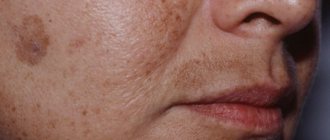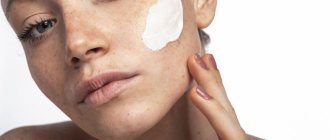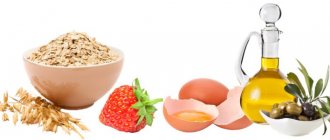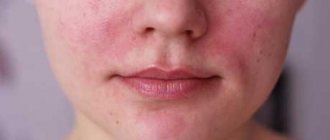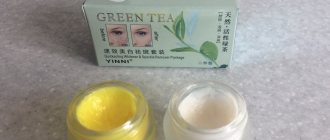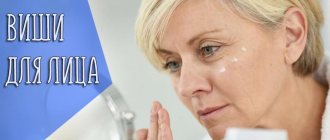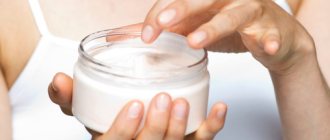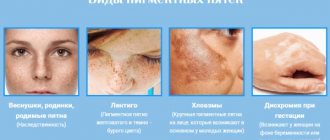The appearance of the face has a special meaning for every person. Many of us put a lot of effort into keeping the skin structure of this part of the body clean, healthy and well-groomed.
However, sometimes unpleasant phenomena such as spider veins or telangiectasias may appear on the surface of the skin. This defect is usually the main symptom of a disease such as rosacea.
To effectively eliminate the unpleasant symptoms of the disease, Vichy Idealia PRO cream is used, designed specifically to relieve the manifestations of rosacea. This product allows you to remove capillary networks in a short period of time and improve your complexion.
Know the enemy by sight
Cuperosis is a vascular disease, the symptoms of which can appear on almost any part of the body, but the most favorite place for localization of this disorder is the face.
This disease most often manifests itself as a result of circulatory problems in the upper layers of the skin. Causes:
- consumption of alcoholic beverages;
- smoking - this bad habit has a negative impact on the functioning of the entire circulatory system, thereby provoking the appearance of spider veins;
- Eating hot and spicy foods increases the risk of capillary fragility;
- the development of the disease can be caused by living in aggressive climatic conditions, rubbing the skin of the face with ice, frequent visits to hot saunas, steam rooms, and so on;
- exposure to ultraviolet radiation;
- drinking hot chocolate and coffee;
- frequent stress, emotional swings, nervous breakdowns.
The first symptom of the disease is severe redness of some areas of the facial skin. If this redness is not eliminated in time, the disease progresses. In places of redness, capillaries burst, and in their place a vascular network is formed, which doctors usually call telangiectasia.
To eliminate these symptoms, various local remedies in the form of creams and ointments are used. Recently, Vichy cream for rosacea has been in great demand. It can eliminate all unpleasant symptoms in just a few uses.
First acquaintance - features and composition
Vichy face cream is an effective remedy for the appearance of rosacea and age spots on the skin. Over a certain period of use, it helps eliminate all unpleasant symptoms and puts the skin in order.
When using this product, the capillary walls are strengthened, blood supply improves, and all signs of inflammation and peeling disappear.
Vichy Idealia PRO is available in the form of a cream-serum. Therefore, when using the cream, its active components penetrate into the deep layers of the skin and contribute to the rapid restoration of their structure.
Vichy cream contains a unique active complex DRM-Bright™ + LHA (lipohydroxy acid), which directly affects skin pigmentation. In addition, there are other constituent elements:
- Eperulin . This component has an anti-inflammatory effect and also has a calming effect on the skin.
- Vichy thermal water . It contains a high level of useful components. Thermal water contains a high content of minerals and trace elements.
- Glycerin . This substance promotes maximum skin hydration while using the cream. It attracts and retains moisture in the upper layers of the skin.
- Diacalite . This substance promotes a rapid leveling effect.
- Procysteine (Oxo Thiazolidine Carboxylic acid). This is an amino acid that has increased antioxidant effects.
Treatment methods for rosacea and rosacea
Vascular manifestations on the skin are successfully treated. There are cosmetic procedures that effectively affect dilated and fragile blood vessels. Even with hereditary pathologies.
Laser treatment of rosacea
Doctors at A Clinic recommend a photorejuvenation procedure to effectively eliminate rosacea.
The technique is based on the technology of high-intensity pulsed light (Intensive Pulse Light), where the source is a flash lamp that produces light radiation in the wavelength range from 500 to 1200 nm. The wavelength of the light beam depends on the result that is planned to be achieved. There are three types of effects: on the superficial, middle, and deep layers of the skin.
During photorejuvenation, light beams are directed at vascular formations, as a result of which the hemoglobin that stagnates in them is destroyed (collapses), and the vascular pattern disappears.
According to research from the Cornell University Medical School (USA), satisfaction with the results of photorejuvenation was 92%, while patients underwent a course of five procedures with an interval of 3 weeks between each. The same studies have shown that with photorejuvenation, not only skin defects go away, but also overall skin rejuvenation occurs. Thus, skin elasticity increases by 60%, wrinkle depth is reduced by 70%, pores are narrowed by 65%.
Photorejuvenation also eliminates post-acne, age spots, and acne. This additional cosmetic effect is one of the advantages of this procedure.
The photorejuvenation procedure is completely safe, painless, and does not leave any marks on the skin. Phototherapy does not require a rehabilitation period - it is enough to avoid direct sunlight and tanning for some time.
To get rid of rosacea, 3-5 photorejuvenation procedures with an interval of three weeks are enough.
Medicinal properties
Vichy cream can quickly eliminate spider veins and capillary networks that appear during the development of rosacea.
The constituent components penetrate deep into the skin layers and contribute to the rapid restoration of damaged capillaries, strengthen and restore the elasticity of the walls of blood vessels.
According to scientific research, Vichy healing serum can relieve symptoms of rosacea by 33%, and pigmentation by 27%. As a result of use, the skin becomes soft, pores narrow and wrinkles disappear. With constant use, the disappearance of the capillary network and smoothing of the facial skin are observed.
Indications for use
Vichy universal anti-rosacea cream, in addition to its direct purpose, is also used to eliminate the following skin diseases:
- solar pigmentation, which appears as a result of ultraviolet radiation;
- to get rid of hormonal pigmentation;
- helps eliminate the appearance of age spots;
- eliminates melasma;
- signs of post-acne;
- various inflammatory processes that appear as a result of impaired blood circulation in the vessels.
Thanks to its complex and balanced composition, the cream allows you to quickly eliminate all unpleasant changes in the skin of the face.
In addition, its components have antiseptic and anti-inflammatory effects. The composition of the cream protects the skin from the negative effects of sunlight and the negative effects of environmental factors.
Mesobotox against rosacea
Botulinum toxin, getting under the skin, begins to affect the hormone serotonin, as well as ion channels responsible for the appearance of many signs of rosacea (the effect of dilated blood vessels) and its chronic form - rosacea.
This allows you to normalize neurovascular disorders and, thereby, reduce the severity of redness and uneven skin texture. Botulinum toxin also has the ability to reduce the hyperactivity of subcutaneous vessels and normalize blood microcirculation in them. This leads to a decrease in persistent erythema and a significant decrease in the intensity of redness as a result of sudden flushes of blood to the face, which often occur in patients with rosacea during physical activity, stress, exposure to hot water, wind, frost and other negative factors.
How to apply
Before using the healing serum, the surface of the skin must be thoroughly cleaned and rinsed. After this, the face should be thoroughly wiped with a towel.
The cream is applied to the entire surface of the facial skin, but it is not recommended to apply to the area around the eyes. The Vichy remedy is used twice a day.
The cream can be used both as a stand-alone product and in conjunction with other cosmetics intended for daily skin care.
Advantages of the product
First of all, the use of Vichy cosmetics helps eliminate the capillary network that forms on the surface of the skin due to rosacea.
With regular use of this product, you can quickly restore the normal condition of the skin and remove unpleasant defects from its surface.
In addition, Vichy cream has the following advantages:
- due to the fact that Vichy Idealia PRO uses a unique complex DRM-Bright + LHA, its action goes in three directions at once - unsightly capillary networks are treated and eliminated, inflammation is relieved, and the underlying disease that caused the appearance of these disorders is treated;
- relieves swelling and inflammation;
- helps restore healthy color and appearance of the surface of the facial skin;
- it can be used by all people, regardless of skin type and age category;
- in addition to rosacea, the cream quickly prevents pigmentation;
- normalizes the process of melanin production;
- the use of this product allows you to exfoliate dead skin cells of the epidermis;
- renews the skin structure at the cellular level;
- with regular use, significant changes in the appearance of facial skin are observed - signs of rosacea disappear, facial skin color evens out;
- this cream can be used by allergy sufferers;
- after using the serum, fine wrinkles are smoothed out and disappear;
- the cream does not form a film or stickiness after application;
- All active components of the product instantly penetrate deep into the skin and do not cause tightness.
The whole truth about spider veins
Spider veins are not a disease!
So, spider veins or, as they are often called capillaries (telangiectasis), are not exactly a disease, but rather a cosmetic problem! This is the honest truth, which is often passed off as varicose veins.
Yes, on the one hand it is varicose veins, but varicose veins are at the level of skin vessels - capillaries and intradermal veins. Such microvaricose veins do not cause any painful symptoms, pain, cramps, swelling, or blood clots. Nothing. Only aesthetic discomfort.
Patients who often come in with pain in the legs, swelling, and discomfort in the calves notice spider veins on their legs and place all the blame on them. And therefore, instead of “treating” with a newfangled “anti-varicose” gel in the area of blood vessels, we recommend looking for the real cause of your discomfort in the condition of your legs (meaning symptoms) - for example, “heavy leg” syndrome, flat feet, chronic venous insufficiency, spinal osteochondrosis, etc. d.
Spider veins are not a disease, which means there is no need to strengthen the blood vessels!
Strengthening blood vessels with medications and gels is a waste of time. You can train muscles, ligaments, and develop endurance. But the blood vessels cannot be strengthened even with the help of medications.
What do we know about spider veins (webs)?
The problem is cosmetic and widespread, spider veins appear at different ages in approximately 70% of women due to the fact that female sex hormones are synthesized in the female body, starting from adolescence, and this stimulates the translucency of intradermal veins, and with age, the appearance of such unwanted elements like spider veins.
For example, a 9-month pregnancy and the accompanying changes in a woman’s body at the hormonal level, as a rule, aggravate the problem. This is normal and physiological, and most importantly, harmless.
That is, you can be calm about your health.
Is there a way to prevent the appearance of unwanted vascular elements?
You can read for hours on the Internet about preventing the appearance of ill-fated blood vessels. And even watch it on TV in popular talk shows. This is a good business - the problem is very common, and if you come up with some kind of “miracle remedy”, many will definitely try it and buy it. There used to be a drug called Asklezan - both tablets and gel. It was necessary to smear and drink 4-6 courses and they supposedly became smaller or “faded” or decreased. In general, they wrote about it in newspaper advertising, people ran and bought it. They smeared themselves. Well, of course, the effect is zero.
There is no way to prevent the appearance of spider veins!
They will gradually appear at different rates in different periods of life.
And if you don’t like it, you can think about treating existing unaesthetic telangiectasis, but it is impossible to slow down or stop this process, even if you take courses of venotonics and daily smear the area of the spider veins with various venotonic creams with or without leeches. This will not affect the process of their appearance and progression in any way.
Treatment of spider veins with medications is useless!
The basic concept of treatment for telangiectasis is not treatment of the whole body or strengthening of blood vessels or drug support by introducing any drugs into the area of spider veins using gels - this is a waste of time. Not a single star will fade, not a single one will disappear. It is a fact. All we can do is inject a sclerosant into the vascular element so that it damages the inner layer of the asterisk and it closes (sclerotherapy, or rather microsclerotherapy) or electrocoagulate the vessels every millimeter or percutaneously treat with a laser again every mm.
That is, the main concept of treatment is to destroy the vascular element in one way or another without damaging anything around it.
Percutaneous laser coagulation
Special lasers are used to treat telangiectasis. The basic principle of treatment is this: a laser beam passes through the skin and is absorbed by the red blood in the vessel, after which the blood heats up and explodes. The vessel is “brewed”. This is a very good method, but only for small and very superficially located meshes, for example, on the face and torso. On his feet he works very unsteadily and it is difficult to get results. Used in Russia mainly by cosmetologists.
In my opinion, a significant disadvantage of percutaneous laser coagulation for leg telangiectasis is the limitation in the diameter of the vessels, the high pain of the procedure and the high probability of difficult to predict side effects (burns of the skin surface, depigmentation in the affected area).
Electrocoagulation of capillaries
Using a very thin needle-electrode, many injections are made into the capillaries with simultaneous exposure to electric current. The procedure is painful and requires anesthesia with a skin anesthetic cream (EMLA on the legs takes effect after 2 hours of exposure under cling film). Therefore, you either smear yourself with Emla cream at home and wrap your legs in film and come to the doctor, or you receive hundreds of rather painful injections. The frequency of injections into the capillary is every 1-1.5 mm. That is, 1 cm of capillary will require 6-10 injections.
Sclerotherapy is the method of choice
Sclerotherapy is an injection technique for the treatment of spider veins and reticular veins. It is most effective against small veins and capillaries. Its meaning is to introduce a sclerosant into the lumen of the vessel, which causes chemical damage to the inner layer of the vessel, followed by its “closure”. After the vessel has closed, it begins to gradually dissolve (several weeks - several months).
Today, sclerotherapy of reticular (intradermal veins) and capillaries is called microsclerotherapy and has many modifications; moreover, everyone performs it differently, so the results can also be very different.
Types of microsclerotherapy
There is a technique of liquid sclerotherapy, when the sclerosant is administered in the form of a solution and this works well on small capillaries with low-intensity blood flow, and a technique of introducing foamed sclerosant (foam-form sclerotherapy), when air or other gas (CO2, for example) is added to the sclerosant, whipped by distillation through an adapter from one syringe to another and after 10-20 strokes a stable foam is obtained.
The sclerosant foam introduced into the lumen of the vessel expels blood well and is well retained there. Foam-form sclerotherapy works better on vessels with more intense blood flow.
Liquid sclerosant works more intelligently and gently, with a minimum of side effects, foam is more aggressive. In the same treatment area, liquid sclerotherapy can be used for some veins and capillaries, and foam for others. A phlebologist can use various scleropreparations, of different concentrations, in liquid or foam form during one session on one treatment area. It all depends on his experience, working style, etc. This is about the active advertising of the miracle method of foam-form sclerotherapy, which is separately positioned as a newfangled and very effective method. We've been using foam for about 10 years and it works great in certain situations, but not much else, especially with mesh.
Microsclerotherapy - a special approach
When it comes to sclerotherapy for spider veins, it is necessary to immediately clarify the situation.
This is an intelligent problem and requires a certain doctor’s experience and a certain technological approach.
It is necessary to take into account the volumes of the administered drug and its concentration. On the other hand, today microsclerotherapy is a methodologically verified procedure, and if everything is done according to technology, then the results will be as expected.
What patients don't understand
First of all, after sclerotherapy sessions, aesthetic results will not be immediate, but after some time. The fact is that closed vessels are visible through the skin and are noticeable. That is, if after the injections the spider vein does not close, then it does not change its color and remains the same as it was; if it closes, it darkens (the remaining small amount of coagulated blood shines through the skin).
The entire time that sclerotic telangiectasis is resolving, it will be noticeable. As soon as it dissolves, the marks will disappear.
This applies not only to sclerotherapy, but to any other effective treatment method. And it is important to understand this before you decide to undergo sclerotherapy. It is necessary to choose the right time for treatment so that you have a reserve of time for aesthetic rehabilitation.
How to get rid of spider veins?
It is clear that you are reading this to understand how you can improve the aesthetics of your legs. Considering the fact that in most cases the method of choice for primary treatment is sclerotherapy, it makes sense to see a phlebologist. An ultrasound of the venous system will be performed and treatment will be recommended. Naturally, in cases of small red capillaries, percutaneous laser coagulation (PLC) may be recommended to you, but this is unlikely, since PLC is usually used for follow-up treatment (only small red capillaries) and usually by cosmetologists.
In most cases of reticular varicose veins, the treatment area includes reticular (feeding) veins (blue), large and medium capillaries (purple) and small ones (red).
In order for the treatment to be effective, the phlebologist begins with the reticular (feeding) veins (marked with blue arrows in the photo), then moves on to large capillaries, then to medium and small ones. Of course, only red vessels can be treated, but practice shows that this is ineffective if the feeding reticular vein remains.
Stage one - sclerosing the “feeding” reticular veins
Often reticular veins communicating with telangiectasis are clearly visible without any equipment (magnifying glasses, polarized light). However, at the same time, poor results of sclerotherapy are associated with poor visualization of these very feeding veins, which can be obscured by the spider veins located above them. A solution to this problem has been proposed by companies that produce Veinviewers - devices based on the thermal imaging effect, which allow brilliant visualization of intradermal veins.
The phlebologist begins the session under the control of Veinviewer, punctures the feeding vein and closes it by injecting a sclerosant.
This is a simple and effective technology that we have been using for over a year to more successfully treat spider veins. Moreover, Venovisor makes it possible to clearly see the vein from which the unwanted vascular element is filled. Veinviewer technology is the key to understanding the problem of spider veins.
Stage two - sclerosing spider veins (telangiectasis)
This is a very simple manipulation at first glance - injecting the drug into the spider veins. The vascular network is punctured with a very thin needle and a small amount of sclerotherapy is injected into it. The introduction is slow and very small in volume.
This allows you to avoid long-term side reactions (matting (see below), pigmentation). Sclerotherapy can be most successful with multiple injections and small amounts of sclerotherapy.
After the introduction of sclerosant, we observe the redness of the element and its reaction. There may be a slight tingling sensation in the injection area. Thus, in the first session, as a rule, the feeding reticular veins are treated, in the second and subsequent sessions - telangiectasis (spider veins).
A few words about haste in treatment
You come 2-3 months before your vacation with the desire to get rid of capillaries, but you did not know that you cannot rush in the treatment of spider veins.
A number of side effects, which can then subside for months and years, are associated not only with the sclerotherapy technique, but also with short breaks between sessions.
Ideally, a session on one leg in the same zone should be carried out at intervals of 3-4 weeks. This is the optimal schedule. That is why we recommend treating spider veins as planned, taking into account your vacations and beach holidays and “much in advance.”
How to make injections painless and improve the results of sclerotherapy?
In microsclerotherapy, injections are performed with cosmetic needles with a diameter of 0.3 mm. These are very thin needles and the injection is insensitive. However, some patients are afraid of injections and for them this type of treatment creates psychological stress. We have solved this problem because we perform cryosclerotherapy. The technique was born in the USA and, with the light hand of the well-known Luis Navarro, was called painless sclerotherapy.
This new method involves cooling the skin for a few seconds with a blast of cold air before injection, creating cold anesthesia of the skin. This is enough so that the patient does not feel the injection.
The miracle of cryosclerotherapy
As it turned out later, this is not the only positive thing from cryosclerotherapy - bruises, hematomas, pigmentation and other side effects after the session are much less than after conventional sclerotherapy. This is due to local vasospasm in the treatment area. And, as a result, in spasmodic vessels the sclerosant works more effectively with a lower concentration and a smaller injected volume.
Compression and sclerotherapy
It has always been believed that round-the-clock compression is necessary for the entire period of sclerotherapy - during the day with stockings, at night with an elastic bandage, plus another 2 months after the end of treatment. That is, only six months. For many patients this was unbearable. But if this is true, then only for sclerosis of large veins. When performing microsclerotherapy of spider veins and reticular veins, compression is usually needed until the evening - either a bandage or stocking. The main purpose of compression in such cases is to reduce the formation of bruises after the session. In rare cases, the daily compression regimen can be extended to 3-5 days.
Modern technology for microsclerotherapy allows this type of treatment to be carried out with virtually no compression and at any time of the year, even in summer.
Innovations in sclerotherapy
Globally, the microsclerotherapy technique has not changed. Same drugs, same injections. Foam-form sclerotherapy, when used on spider veins, usually does not live up to expectations, so sclerotherapy with a liquid solution is preferable. However, since 2013 we have introduced a couple of innovations in technology: cooling the skin during the procedure and the use of a Veinviewer.
These improvements make the procedure more comfortable, reduce the number of side effects, and improve control over the administration of the drug.
Possible side effects of microsclerotherapy
Pigmentation
The most common side effect of microsclerotherapy is pigmentation at the site of sclerotic veins and spider veins. After administration of the sclerosant, the inner layer of the vessel is damaged; at first the vessel disappears, but after a few minutes it fills with blood again. If the vessel subsequently thromboses (closes), then a black tar-like mass (coagulum) is formed in it, which is darker than blood and the vessel shines through the skin brighter than the original one. Over time, the closed vessel with coagulum dissolves. Usually this is several months. If this process is long and the coagula is quite pronounced, then iron is deposited in the skin and it becomes light brown. Actually this is called pigmentation. In most cases, pigmentation goes away within six months, but in 5% of cases it can take a year and in 1% of cases up to 2 years. But it always passes, which makes me happy.
The severity and duration of pigmentation after sclerotherapy is individual and depends on the characteristics of pigment metabolism in the patient’s body.
Matting (neovascularization)
Matting is a reaction in the form of the appearance of small capillaries in the treatment area. This is a complex and sometimes difficult to explain and predictable phenomenon. It is largely determined by hormonal levels (manifested in women), as well as by the individual reaction to the administration of sclerosant. Most often associated with the use of high concentrations of scleropreparation or a large volume of administration.
That is why you should not try to inject all the vessels at once in the first session - the dose may be large and this will cause an undesirable reaction.
Most often, matting occurs if sessions on one leg occur very often (once a week, for example). A more gradual style of treatment with longer breaks produces better results. You should also not conduct more than 3 sessions in a row on one leg without a long break (3-6 months).
How to minimize the risk of side effects during sclerotherapy?
Introduce a small amount of sclerosant through multiple injections, take long breaks, and take a long rest after 2-4 sessions. Sclerotherapy should be like the leisurely work of an artist who gradually draws the details of a picture.
That is why it is necessary to approach your treatment without haste and without any limiting circumstances. Choose a time and go to the procedures calmly.
#FORM_PSK1#
